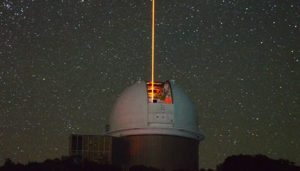Follow-up studies of candidates planetary systems found by NASA’s Kepler mission suggest that companion stars make some worlds appear smaller than they really are.

Christoph Baranec
NASA’s Kepler mission gave astronomers a bountiful supply of homework. Checking up on the 4,000-plus candidate exoplanets that it turned up is a daunting task. Among those tackling the list is the Robo-AO team. Robo-AO is an automated laser-guided adaptive optics system, which when hooked up to a large telescope (most recently, the 2.1-meter on Kitt Peak) enables rapid-fire observations of a couple hundred stars each night.
The Robo-AO team has been checking each of Kepler’s candidate-planet-hosting stars to see if any other stars are lurking nearby. Nearby stars can muck up estimates of what the host star is really like (temperature, size) and even create signals that look like exoplanets but aren’t.
It turns out that extra stellar companions can also make exoplanets look smaller than they really are. Carl Ziegler (University of North Carolina, Chapel Hill) reported that take-away as part of the big-picture results from the Robo-AO project on January 9th at the American Astronomical Society meeting in Washington, D.C.
Of 3,857 stars observed with Robo-AO, more than 600 had stellar companions. The light from this extra star can contaminate exoplanet detections with extra light, making their dips appear smaller and thus giving the impression that the planet candidates themselves are smaller than they really are. Broadly speaking, having another star in the system means planetary radii are roughly a factor of 2 larger than they appear. The team found that due to this contamination, 8 of the 26 potentially rocky, habitable-zone worlds studied might be gaseous. Among the candidates are the confirmed planets Kepler-438b and Kepler-437b. If these worlds orbit the primary star in the system, they’re still rocky, but if they instead orbit the secondary star, they’re 2 to 3 times larger than estimated and thus gaseous.
The team also sees indications that hot Jupiters are roughly four times more common in systems with more than one star than they are around single stars. Astronomers have previously suspected that a stellar companion could gravitationally mess with a gas giant enough to push it into a much smaller orbit around its star than it originally formed at. The Robo-AO results support that idea.
You can learn more about the project on the team’s website.
Reference:
Carl Ziegler. “Robo-AO KOI Survey: LGS-AO imaging of every Kepler planetary candidate host car.” 231st AAS Meeting. Abstract 128.05.
Carl Ziegler et al. “Robo-AO Kepler Survey IV: The effect of nearby stars on 3857 planetary candidate systems.” arXiv.org. Posted December 12, 2017.
Learn more about exoplanets with MIT astronomer Sara Seager in our exoplanet webinar.
 1
1









Comments
Rod
January 22, 2018 at 2:12 pm
Good report and good catch here on possible larger exoplanets in habitable zones. My calculations indicate a model 2 earth radii exoplanet with mean density 5.5 grams cm^-3 is about 8 earth masses. The surface gravity, about 2g of Earth's. A 12 earth mass exoplanet with 4 earth radii could have mean density about 1 gram cm^-3. An 8 earth mass body with 4 earth radii could have mean density about .69 grams cm^-3. Some habitable zone exoplanets could indeed be large, gaseous bodies.
You must be logged in to post a comment.
You must be logged in to post a comment.